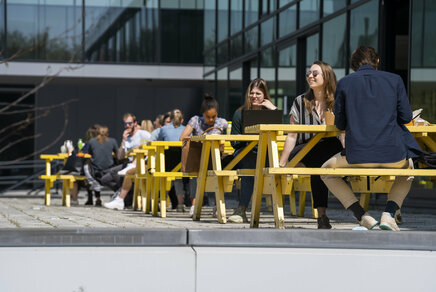Towards a fundamental understanding of energy-efficient, plasma-based CO2 conversion
Omar Biondo defended his PhD thesis at the department of Applied Physics and Science Education on July 3rd.
![[Translate to English:] [Translate to English:]](https://assets.w3.tue.nl/w/fileadmin/_processed_/2/2/csm_Biondo%20Banner%20image_39f9b3a3fe.jpg)
Plasma-based CO2 conversion is gaining increasing interest around the world. For his PhD thesis, Omar Biondo sought potential pathways to improve the energy efficiency of plasma-based CO2 conversion beyond what is feasible for thermal chemistry.
To achieve his PhD research goal, Omar Biondo and his collaborators from the Elementary Processes in Gas Discharges group (TU/e) and the University of Antwerp used a combination of modeling and experiments to better understand the underlying mechanisms of CO2 conversion, ranging from non-thermal to thermal equilibrium conditions.
Zero-dimensional modelling
Zero-dimensional (0D) chemical kinetics modelling, describing the detailed plasma chemistry, were developed to explore the vibrational kinetics of CO2, as the latter is known to play a crucial role in the energy efficient CO2 conversion.
The 0D model was successfully validated against pulsed CO2 glow discharge experiments, enabling the reconstruction of the complex dynamics underlying gas heating in a pure CO2 discharge, paving the way towards the study of gas heating in more complex gas mixtures, such as CO2 plasmas with high dissociation degrees.
Reactive addition
Energy-efficient, plasma-based CO2 conversion can also be obtained upon the addition of a reactive carbon bed in the post-discharge region. The reaction between solid carbon and O2 to form CO helps to both reduce the separation costs and increase the selectivity towards CO, thus increasing the energy efficiency of the overall conversion process.
In this regard, a novel 0D model to infer the mechanism underlying the performance of the carbon bed over time was developed by Biondo. The model indicates that gas temperature and oxygen complexes formed at the surface of solid carbon play a fundamental and interdependent role. These findings open the way towards further optimization of the coupling between plasma and carbon bed.
Experimental check
Experimentally, Biondo demonstrated that “warm” plasmas (e.g., microwave or gliding arc plasmas) yield very high energy efficiency for CO2 conversion, but typically only at reduced pressure.
For industrial application, it will be important to realize such good energy efficiency at atmospheric pressure as well. However, recent experiments illustrate that the microwave plasma at atmospheric pressure is too close to thermal conditions to achieve a high energy efficiency.
Hence, Biondo employed a comprehensive set of advanced diagnostics to characterize the plasma and the reactor performance, focusing on CO2 and CO2/CH4 microwave discharges. The results lead to a deeper understanding of the mechanism of power concentration with increasing pressure, typical of plasmas in most gases, which is of great importance for model validation and understanding of reactor performance.
Title of PhD thesis: Towards a fundamental understanding of energy-efficient, plasma-based CO2 conversion. Supervisors: Annemie Bogaerts (External, University of Antwerp) and Gerard van Rooij.
Media contact
Latest news


